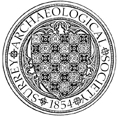RSG Zoom Talk - Emma Corke on 'Discoveries at Cocks Farm Abinger 2024'
Emma Corke, Director of the Cocks Farm Abinger excavations, will be telling us about the latest discoveries at Cocks Farm Abinger. Fieldwork has been taking place in the area outside the known Roman villa for more than a decade, and has revealed evidence for wider land use, both during the Roman period but also in prehistory.
The Zoom link will be sent a week in advamce to RSG members. If you are a SyAS member you can join RSG for free - just click on the membership tab and follow instructions to join RSG.


